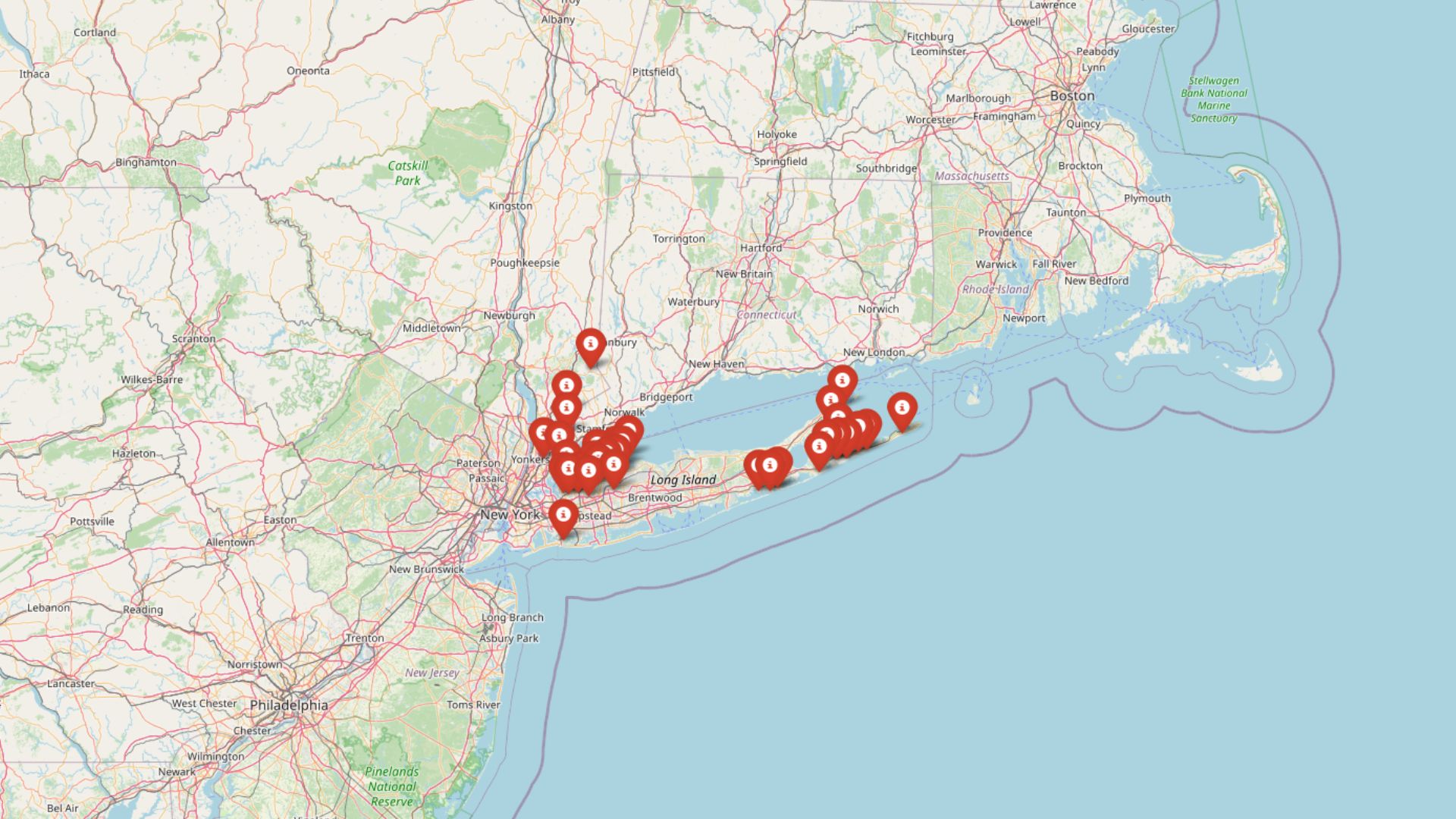Considering a move to Copenhagen, New York? Let’s explore everything you need to know about this small rural village in upstate New York’s “North Country” region.
Copenhagen offers an affordable cost of living, exceptionally low crime rates, and easy access to outdoor recreation, particularly winter sports thanks to its significant annual snowfall. While the village itself has limited amenities, it sits within easy driving distance of larger towns like Watertown and Lowville for shopping and services.
We’ll look at housing costs, the job market, commuting realities, healthcare access, education quality, climate conditions, and community life to help you determine if Copenhagen’s small-town atmosphere might be right for you.
Demographics
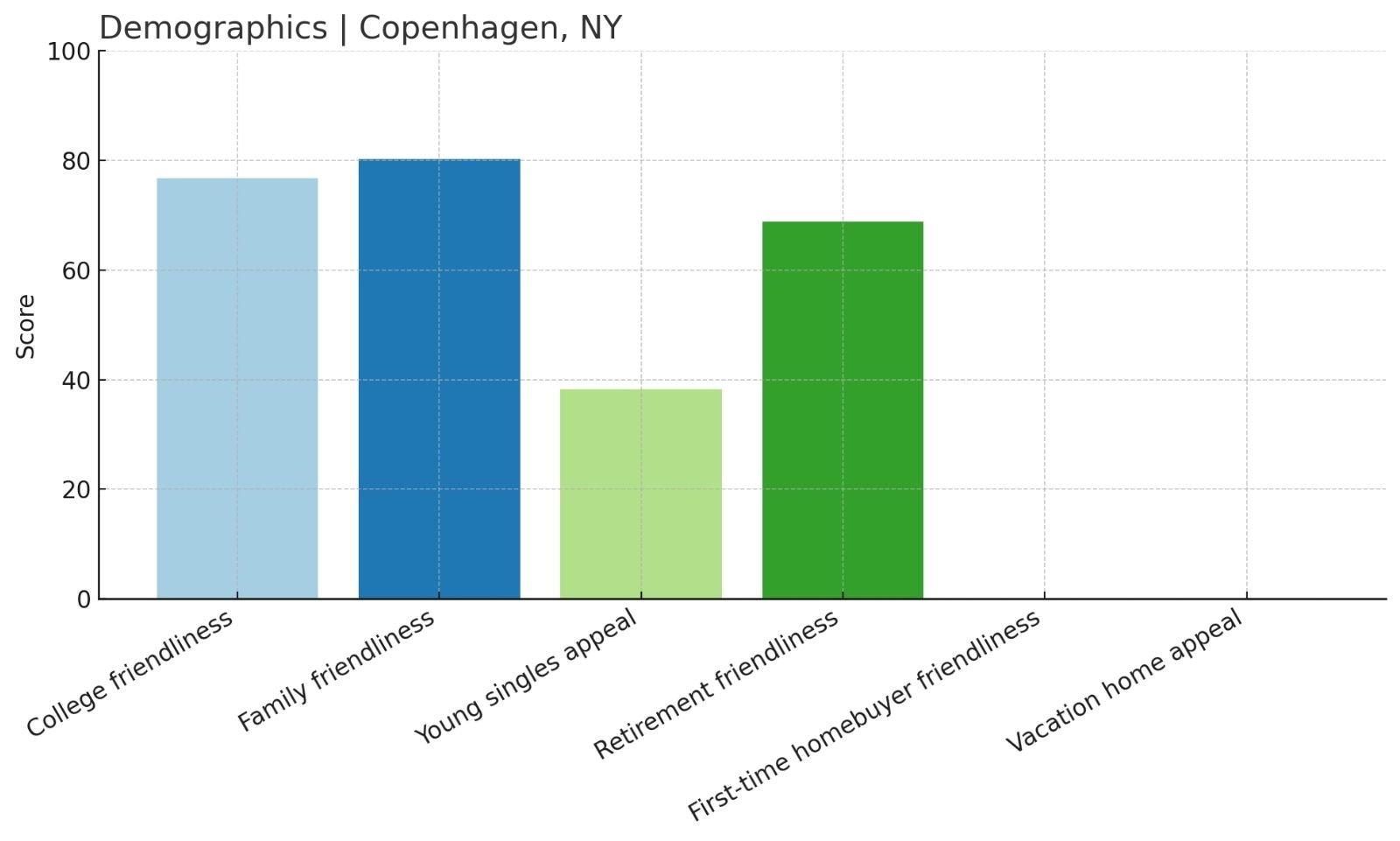
College friendliness: 76.66
Family friendliness: 80.27
Young singles appeal: 38.31
Retirement friendliness: 68.81
- First-time homebuyer friendliness: 0.00
- Vacation home appeal: 0.00
Copenhagen, NY shines as a family- and college-friendly town, with solid marks for retirees as well. However, it holds little appeal for first-time buyers or as a vacation destination. Its demographic profile suggests a stable, community-oriented environment—ideal for settling down or enjoying a slower pace of life, but not geared toward transient or leisure-focused living.
Lifestyle
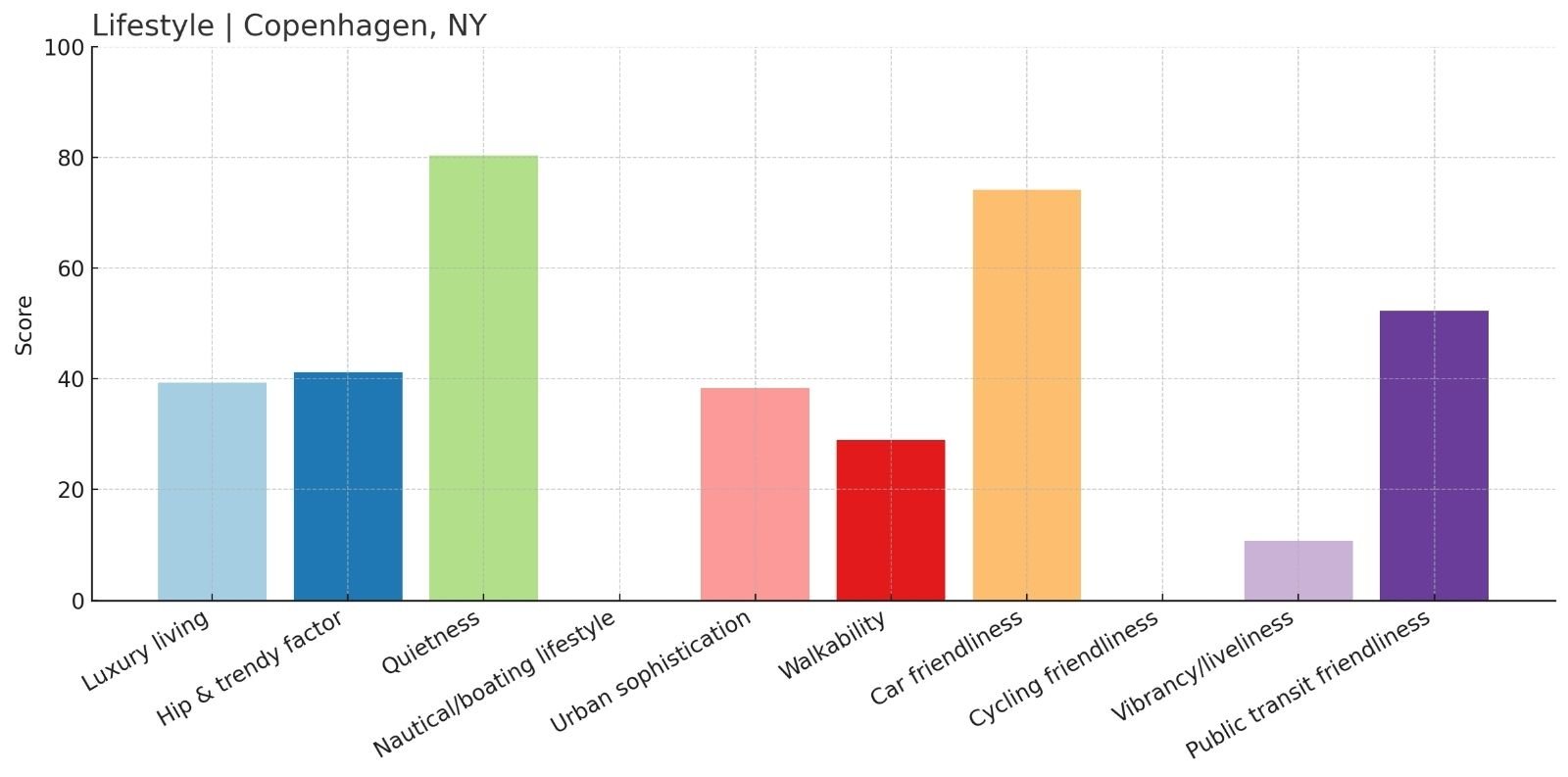
- Luxury living: 39.33
- Hip & trendy factor: 41.23
- Quietness: 80.34
- Nautical/boating lifestyle: 0.00
- Urban sophistication: 38.32
- Walkability: 28.91
- Car friendliness: 74.11
- Cycling friendliness: 0.00
- Vibrancy/liveliness: 10.77
- Public transit friendliness: 52.24
Copenhagen, NY ranks high for peace and quiet, as well as being car-friendly, making it ideal for those seeking a calm, suburban or rural feel. While it offers decent access to public transit, its scores suggest minimal urban flair or energetic social life. There’s little emphasis on trendy experiences, walkability, or outdoor activities like boating or cycling. It’s clearly tailored more toward residents who prioritize tranquility and practicality over buzz and bustle.
Housing Market
The housing market in Copenhagen is very affordable by both state and national standards. The median home value is around $190,000, which is considerably less than the U.S. median ($303,400) and significantly less than New York State’s median home value (which is over $400,000).
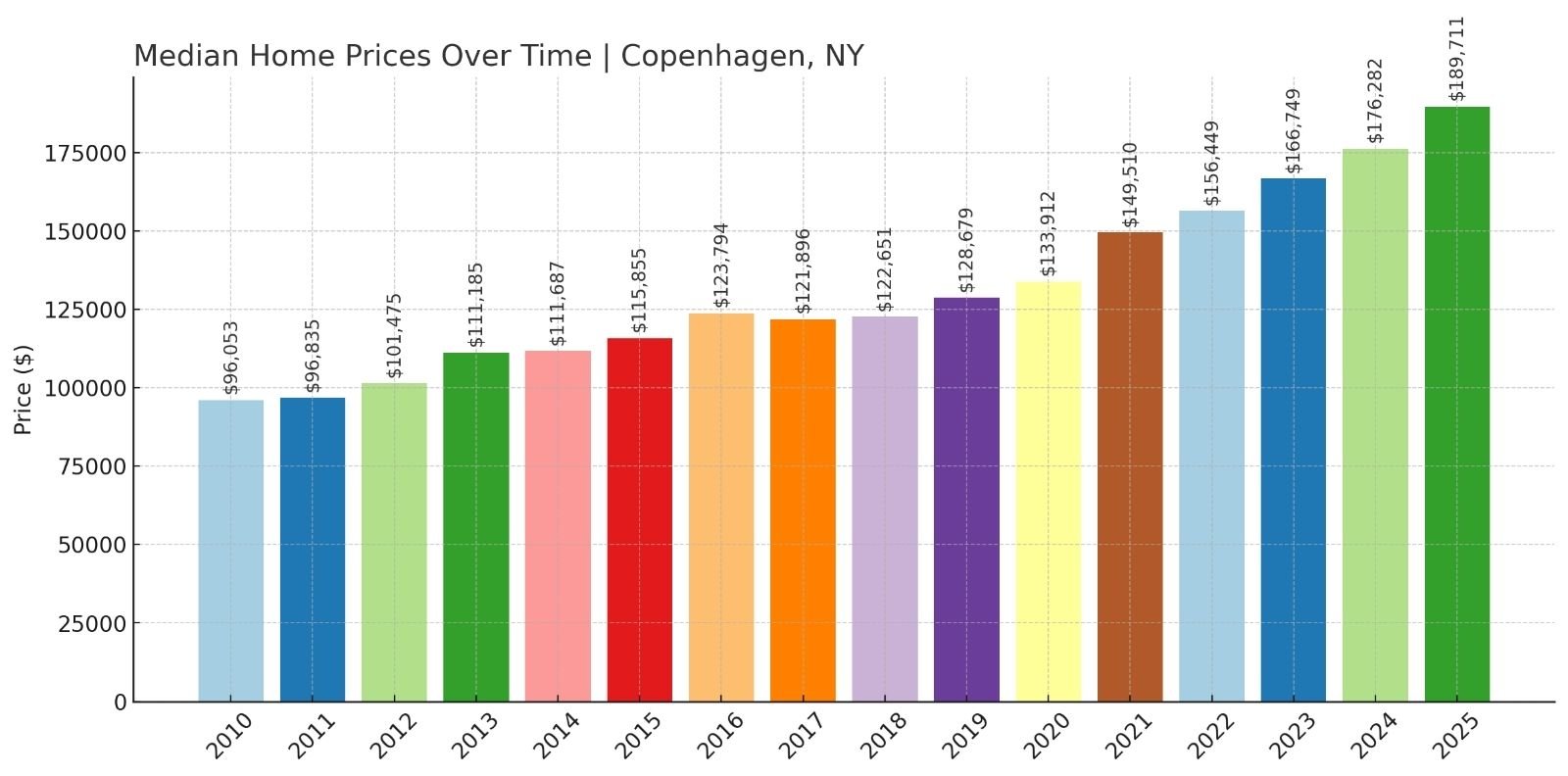
Home prices in Copenhagen are roughly 45% lower than the national average, reflecting the low-cost, rural nature of the area. Most homes are single-family houses, often on sizable lots, ranging from older farmhouses and modest village homes to some newer constructions. This keeps homeownership within reach for many – young families, first-time buyers, or retirees.
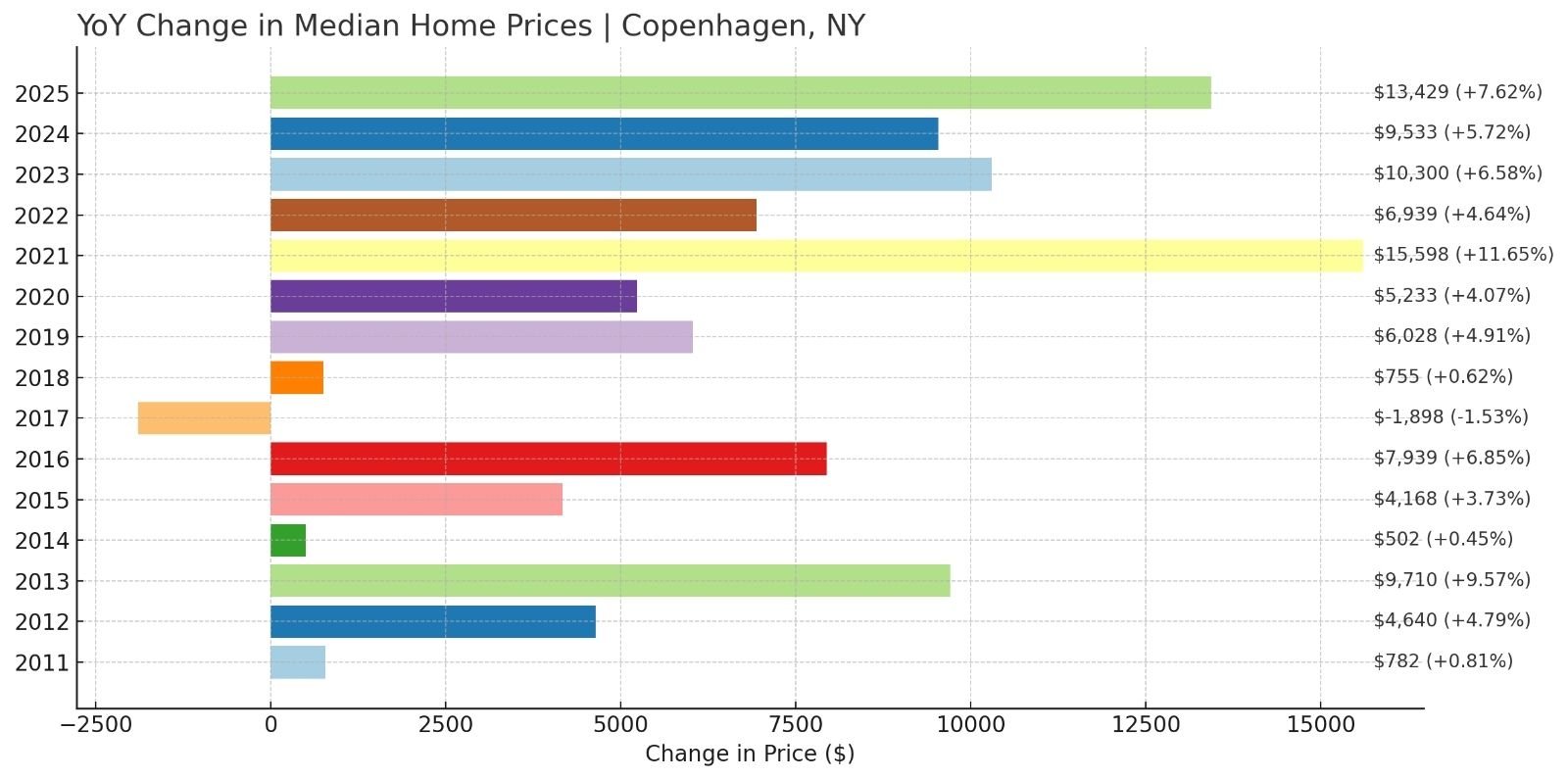
Copenhagen, NY has seen consistent home price growth over the past 15 years, with only one minor setback in 2017. Notably, prices jumped significantly in 2021 and again in 2025, signaling spikes in demand. The overall trend suggests steady appreciation, making it an increasingly valuable housing market, especially appealing to long-term investors or homeowners seeking affordability with future upside. Now let’s build the YoY change chart.
Rental Market
Renting is similarly budget-friendly. The median rent in Copenhagen is about $983 per month, well below the national median rent (~$1,348). It’s not unusual to find apartments or houses for rent in the ~$700–$1,000 range, which is 27% lower than the U.S. average rent.
About 54% of residents own their homes and 46% rent, indicating a fairly balanced market between homeowners and renters. This higher-than-average renter proportion may be due to military families or young professionals who choose to live in the village and commute to work (Fort Drum and Watertown are nearby).
Housing stock in town is somewhat limited by the village’s small size, but vacancy rates are typically low.
Cost of Living
Copenhagen, New York offers a relatively low cost of living compared to both state and national benchmarks. The overall cost of living index here is about 18.5% lower than the U.S. average and roughly 32.9% lower than the New York State average.
Housing is the most significant factor: a typical home in Copenhagen costs around $181,100, which is less than half the U.S. median home price (≈$338,100). Rent is also affordable – a two-bedroom unit averages about $1,170 per month, noticeably cheaper than the national average (~$1,430). Other day-to-day expenses like groceries, utilities, and healthcare tend to be moderate and budget-friendly.
When compared to nearby cities, Copenhagen’s cost of living is lower than in Watertown or Syracuse. For instance, Watertown’s cost index is around 87 (U.S. average = 100) and Syracuse’s is about 87.4, whereas Copenhagen scores roughly 81.5.
A family can live comfortably on a modest income here; one estimate suggests about $34,560 per year for a family could suffice for basic living expenses in Copenhagen.
Safety and Crime
Copenhagen’s crime rates are very low. The village sees minimal violent crime – with a recent violent crime index of only 8.0, far below the U.S. average of 22.7. Property-related crimes are also infrequent; Copenhagen’s property crime index is about 20.8, compared to a national average of 35.4.
These numbers suggest that incidences of burglary, theft, or vandalism are relatively rare. In fact, the community’s violent crime level is significantly lower than national and state norms.
By comparison, larger nearby cities like Watertown experience higher crime levels, which is typical when contrasting a small village to an urban center. Residents of Copenhagen benefit from the town’s tight-knit atmosphere and proactive local law enforcement, contributing to a general sense of safety.
Transportation and Commuting
Driving is the primary mode of transportation for Copenhagen residents, as is common in rural upstate New York. The village is situated on New York State Route 12, the main artery through town, which provides convenient connections to other communities.
Route 12 leads northwest about 14 miles to Watertown (the nearest city and access point to Interstate 81) and southeast about 12 miles to Lowville. Commuting by car to these hubs is straightforward – typically a 20- to 25-minute drive to either.
The average commute for Copenhagen workers is just about 21 minutes, which indicates many residents work in relatively nearby areas (such as Watertown, Lowville, or the Fort Drum military base). Rush hour traffic is essentially nonexistent in the village; however, winter weather can slow travel.
Public transportation options in Copenhagen are limited to none. There is no local bus or subway system serving the village. Therefore, owning a car (or carpooling) is almost a necessity for anyone living here.
For long-distance travel, residents can drive to Watertown to catch intercity buses or use Watertown International Airport (about a 25-minute drive) for regional flights. Major air travel typically goes through Syracuse Hancock International Airport, roughly 75 miles away.
Local Economy and Job Market
Copenhagen’s economy is intertwined with the broader regional job market of Lewis and Jefferson counties. Within the village itself, employment opportunities are relatively few – the local school, small businesses, and municipal services provide some jobs, but many residents commute for work.
The median household income in Copenhagen is about $75,833, which is on par with the national median and only slightly below the New York State median. The major employment sectors include healthcare, social assistance, and construction. In fact, about 23.5% of Copenhagen’s workers are employed in health care or social services, which is the largest share for any industry.
Construction and skilled trades are also a significant piece of the job market – among male workers, construction trades account for roughly 17% of employment.
Regional Employment
Agriculture remains part of the local economy too. Lewis County’s landscape is dotted with dairy farms and timber operations, and while not everyone in Copenhagen is a farmer, the dairy farming, paper milling, and logging industries form an economic backdrop for the county.
Some Copenhagen residents work in agribusiness or related manufacturing (for example, a Kraft foods cream cheese plant operates in Lowville, which is a major local employer in food processing). Additionally, the proximity of Fort Drum (a large U.S. Army base) roughly 15 miles away means some locals are employed on base or in services supporting the military community.
Watertown, the regional retail and service hub, offers jobs in retail, education (Jefferson Community College, local schools), and government. Unemployment in Lewis County has been relatively low in recent years – around 4–5% in 2024 – indicating a stable job market. However, wages in the North Country are generally lower than downstate New York, even if the cost of living is also much lower.
For someone moving to Copenhagen, it’s important to note that you may likely work outside the village. The good news is that commuting is easy and the region has a variety of jobs in healthcare, education, government, retail, and light manufacturing.
Taxes
New York is known for relatively high taxes, and living in Copenhagen means navigating the state’s tax structure, albeit with some local twists. Property taxes in Lewis County (where Copenhagen is located) are on the higher side in effective rate, even though home values are low. The median property tax bill in the county is about $2,429 per year.
Given the modest home prices, this translates to a median effective property tax rate around 2.38% of a home’s value. This rate is significantly higher than the U.S. average effective property tax rate (~1.0%) and even above the New York State average (~1.54%).
Sales tax in Copenhagen consists of the state sales tax plus county sales tax. New York’s base sales tax is 4%, and Lewis County adds its own local sales tax on top. As of 2025, Lewis County’s sales tax rate is 4.75%, making the combined sales tax rate 8.75% on purchases within the county.
Income tax for Copenhagen residents is determined by New York State, as there are no additional county or city income taxes in Lewis County. New York has a progressive income tax with nine brackets ranging from 4% to 10.9%. Ordinary middle-class incomes typically get taxed at rates between roughly 5% and 6.5%.
Healthcare Access
Despite its small size, Copenhagen has access to a network of healthcare facilities in the surrounding region. Within the village itself, basic medical care is available at the Copenhagen Health Center, a local clinic operated by the Lewis County health system.
For more advanced or emergency medical care, residents rely on hospitals in nearby towns:
- Lewis County General Hospital in Lowville (about 12 miles away) is a 31-bed hospital providing emergency services, inpatient care, surgery, and maternity services.
- Carthage Area Hospital, roughly 10 miles north in Carthage, is a 25-bed critical access hospital that serves the region spanning northern Lewis and southern Jefferson counties.
- The major regional hospital is Samaritan Medical Center in Watertown, about 15 miles from Copenhagen. Samaritan is a 294-bed not-for-profit medical center and offers a full spectrum of care.
Between these options, healthcare access is generally good. Emergency services (ambulances/EMTs) can transport patients from Copenhagen to any of these nearby hospitals quickly (roughly a 15-20 minute drive to reach an ER).
For specialized care, patients sometimes need to travel to larger cities. Complex procedures or specialist consultations might be referred to hospitals in Syracuse or to other large medical centers downstate.
Education
Education in Copenhagen is anchored by a single public school district that serves the community: Copenhagen Central School District. The district is small and typically operates a combined campus (elementary through high school) or closely-linked school buildings, meaning children often attend school with the same cohort from kindergarten through 12th grade.
Notably, public schools in Copenhagen are rated above average and enjoy a positive reputation in the region. The graduation rate is around 90% for Copenhagen Central School, which is slightly higher than the New York statewide average (~87%).
Class sizes tend to be small; the student-to-teacher ratio is roughly 11:1, on par with or better than state averages, allowing for more personalized instruction.
Academically, Copenhagen students meet state standards and often benefit from the resources of a small district (teachers know students by name, and there is strong parent involvement). The district’s performance and the community’s investment in education earned it a “B minus” rating for public schools on at least one review site.
Higher Education
When it comes to higher education and adult learning, there are no colleges in Copenhagen itself, but the region has options. The nearest college is Jefferson Community College (JCC) in Watertown, about a 20-minute drive. JCC is a SUNY (State University of New York) two-year college offering associate degrees, certifications, and continuing education.
For four-year universities, students will need to travel farther: SUNY Potsdam and SUNY Canton are about 1 to 1.5 hours north, SUNY Oswego is around 1.5 hours west, and Syracuse University/Le Moyne College are about 1.5 hours south.
Lifelong learning and specialized training (like BOCES programs for trades) are also available regionally – the Howard G. Sackett Technical Center (BOCES) in Glenfield (Lewis County) offers vocational high school programs and adult education in trades such as welding, agriculture, nursing assistant programs, etc.
Climate and Weather
If you’re considering Copenhagen, NY, be prepared for a true four-season climate – especially winters that are long and snowy. Copenhagen lies in the Tug Hill Plateau region of upstate New York, an area famous for its hefty snowfall.
The village receives an annual snowfall of about 193 inches on average. That’s over 16 feet of snow per year, ranking Copenhagen among the snowiest places in New York State. For perspective, nearby Syracuse (itself known for snow) averages around 110 inches annually, which Copenhagen nearly doubles.
Winter typically lasts from late November through March, with cold temperatures and frequent lake-effect snowstorms blowing off Lake Ontario. January is the snowiest month, often accumulating around 4 feet of snow (≈50 inches) just in that month. Temperatures in winter are frigid: the average January nighttime low is about 7.7°F (-14°C).
Summers, by contrast, are mild and pleasant in Copenhagen. July is the warmest month, with an average high around 77.5°F (25°C). Unlike downstate areas, Copenhagen rarely sees extreme heat; days above 90°F are very rare (maybe one day all year). Summer nights are cool, often in the 50s°F, which can be a relief for those who dislike heat and humidity.
Outdoor Recreation

This climate lends itself to a variety of outdoor recreation opportunities. In winter, the heavy snows make Copenhagen and the surrounding Tug Hill region a destination for winter sports.
Snowmobiling is extremely popular – Lewis County boasts an extensive network of groomed snowmobile trails (hundreds of miles of trails) that attract enthusiasts from across the state. Many residents own snowmobiles or all-terrain vehicles with snow tracks, turning the winter landscape into a seasonal playground.
There are also opportunities for cross-country skiing, snowshoeing, and even downhill skiing nearby; for example, Snow Ridge Ski Resort in Turin (about 25 miles southeast) offers alpine skiing on Tug Hill’s famous powder. Ice fishing is another winter activity on local lakes and ponds.
In the warmer seasons, outdoor recreation shifts to hiking, hunting, fishing, and riding ATVs. Copenhagen is fortunate to sit between the western edge of the Adirondack Park and the Tug Hill Plateau.
One popular nearby destination is Whetstone Gulf State Park (about 15 miles from Copenhagen), which features a dramatic gorge, hiking trails, camping facilities, and a small lake for fishing. To the west of town lies the Tug Hill Wildlife Management Area, a vast forested upland with trails and abundant wildlife – great for hunting (deer, turkey) and hiking in solitude.
The Black River flows just to the north of Copenhagen (through Carthage and toward Watertown) and offers kayaking and whitewater rafting opportunities for adventure seekers.
For those who enjoy motorsports and off-roading, Lewis County has an extensive ATV trail system (about 500 miles) that opens in spring through fall.
Demographics and Community
Copenhagen is a small, close-knit community, and its demographics reflect the rural, family-oriented nature of the area. The village’s population is roughly 650–660 people as of the latest estimates. This population has actually decreased somewhat over the past few decades (a common trend in many upstate New York rural towns).
The median age in Copenhagen is about 31 years, which is notably younger than the state median age of 40. This median age suggests a mix of young families and children alongside middle-aged and older adults. In practice, Copenhagen has many households with kids as well as a contingent of retirees enjoying a quieter life.
The demographic makeup is not very diverse in a racial/ethnic sense. The vast majority of residents are White (around 81%), with a significant portion (15%) identifying as multiracial. Other racial groups (Black, Asian, Native American, Hispanic) each make up only a small single-digit percentage of the population or less.
Community Life
Living in Copenhagen, one can expect a strong sense of community. In a village this small, people greet each other by name at the post office or local diner. It’s common for residents to volunteer with the volunteer fire department, join community events, or support school functions. Annual traditions (a summer field days, holiday parades, or perhaps a local festival or craft fair in the park) are simple but well-attended and cherished.
The general lifestyle is very much small-town rural. Don’t expect fast-paced nightlife or a proliferation of trendy cafes. Instead, evenings might be spent at a high school basketball game, a backyard bonfire, or fishing at a nearby pond.
Housing is spaced out; outside the village center, homes may have acres of land, so privacy is easy to come by. At the same time, privacy doesn’t mean isolation – in a town this size, everyone is connected in some way, and word travels fast (for better or worse).
Amenities and Services

As a rural village, Copenhagen offers basic amenities but limited entertainment and shopping options within town. Residents will find a few local businesses – for example, a diner or family-run restaurant, a gas station convenience store, and essential services like a post office. There are a handful of eateries and small shops that cater to daily needs and create a quaint, small-town charm.
For more extensive shopping and entertainment, locals frequently head to nearby towns and cities. The city of Watertown (about 14 miles northwest) serves as the primary hub for the region. Watertown offers supermarkets, department stores, restaurants (including national chains), movie theaters, and other leisure activities that Copenhagen lacks.
Similarly, Lowville (12 miles southeast), the Lewis County seat, has grocery stores, shops, and community events (like the county fair) that Copenhagen residents utilize. Even larger urban attractions are accessible on occasion – Syracuse, with its malls (e.g. Destiny USA), concert venues, and collegiate sports, is roughly an hour and a half drive south.
In summary, living in Copenhagen means enjoying peaceful small-town life and relying on nearby Watertown or Lowville for most entertainment and shopping beyond the basics.
Conclusion
Living in Copenhagen, NY means embracing small-town life in the North Country. The town provides affordability, safety, and natural beauty in abundance. In exchange, residents adapt to limited commercial amenities, harsh winters, and a slower pace.
With its friendly neighbors, open spaces, and proximity to both nature and necessary services, Copenhagen presents a compelling option for anyone looking to relocate to a quiet corner of New York State that still keeps you within reach of larger towns and modern conveniences.
References
- Copenhagen, NY Cost of Living
- Cost of Living Calculator Watertown, NY
- Cost of Living Calculator Syracuse, NY
- Copenhagen, NY Crime
- Copenhagen, NY Housing Statistics
- Copenhagen, New York – Wikipedia
- Copenhagen, NY – Niche
- Copenhagen, New York Population 2025
- Copenhagen, New York profile
- Lewis County, New York Property Taxes – Ownwell
- New York State Taxes: What You’ll Pay in 2025
- New York Sales Tax Rates By City & County 2025
- Copenhagen Health Center – Lewis County Health System
- Lewis County General Hospital – NYS Health Profiles
- About CAH of New York – Carthage Area Hospital
- Samaritan Medical Center – Wikipedia
- Copenhagen Central School
- Admissions – Jefferson Community College
- Copenhagen, NY Climate
- Lewis County – Britannica
- Adirondack Tug Hill Region ATV Tracks
- Lewis County Demographics


